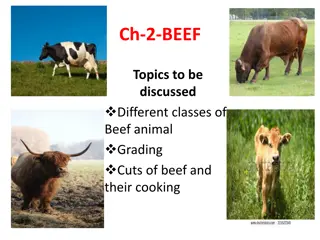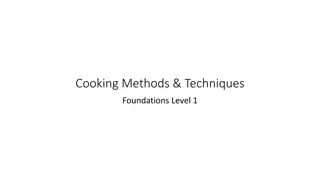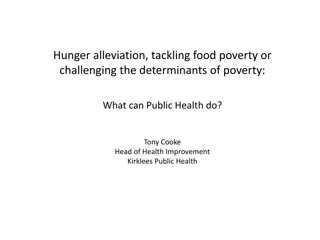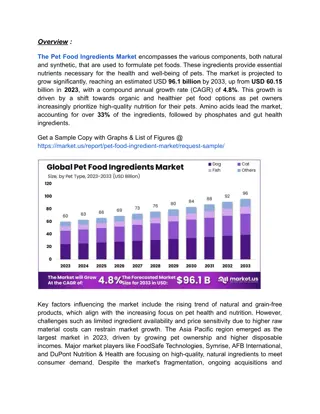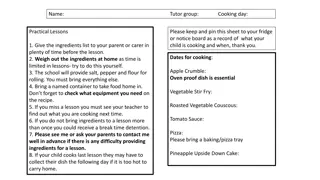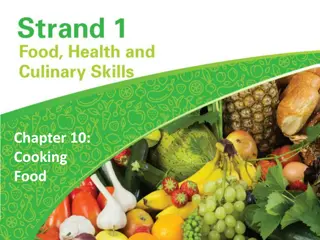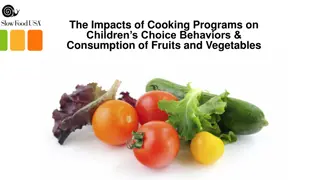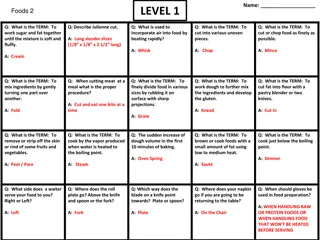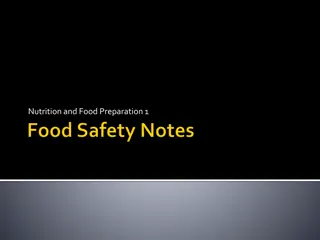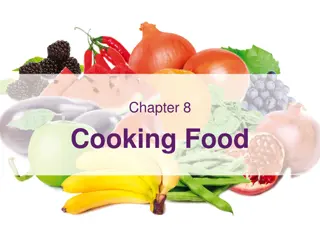Importance of Cooking Food for Health and Palatability
Cooking food is an ancient art that involves the application of heat to enhance digestibility, safety, and flavor. It aims to provide balanced meals, increase palatability, sterilize food partially, extend food preservation, and retain essential nutrients and flavors. Cooking also offers variety to menus by allowing different textures and culinary techniques. It plays a crucial role in maintaining health, preventing foodborne illnesses, and satisfying our sensory experiences.
Download Presentation

Please find below an Image/Link to download the presentation.
The content on the website is provided AS IS for your information and personal use only. It may not be sold, licensed, or shared on other websites without obtaining consent from the author.If you encounter any issues during the download, it is possible that the publisher has removed the file from their server.
You are allowed to download the files provided on this website for personal or commercial use, subject to the condition that they are used lawfully. All files are the property of their respective owners.
The content on the website is provided AS IS for your information and personal use only. It may not be sold, licensed, or shared on other websites without obtaining consent from the author.
E N D
Presentation Transcript
AIMS AND OBJECTIVES OF COOKING FOOD 9/26/2024 Compiled by Dr Shiv Mohan Verma
INTRODUCTION Cooking is the act of preparing food for eating by the application of heat. It encompasses a vast range of methods, tools and combinations of ingredients to alter the flavor or digestibility of food. It is the process of selecting, measuring and combining of ingredients in an ordered procedure in an effort to achieve the desired result. Factors affecting the final outcome include the variability of ingredients, ambient conditions, tools, and the skill of the individual doing the actual cooking. Cooking is an art. It is linked with the dietary habits and cultural pattern of people. The intention of cooking is to see that the food cooked undergoes a physical and a chemical change at the end result is edible and acceptable. 9/26/2024 Compiled by Dr Shiv Mohan Verma
INTRODUCTION The art of cooking is ancient. There is archaeological evidence of roasted foodstuffs, both animal and vegetable, in human camp sites dating from the earliest known use of fire, some 800,000 years ago. Other methods of cooking that involve the boiling of liquid in a receptacle have been practiced at least since the 10th millennium BC, with the introduction of pottery. 9/26/2024 Compiled by Dr Shiv Mohan Verma
COOKING Cooking is the application of heat to food for the purpose of making it more digestible, safer to eat, more palatable and to change its appearance. To cook food, heat must be introduced. In the cooking process the heat breaks down the cellulose in the plant, softens some of the connective tissues in the meat, changes and blends flavours within the food and destroys bacteria, makes food more acceptable to human beings and their digestive system. 9/26/2024 Compiled by Dr Shiv Mohan Verma
AIMS AND OBJECTIVES OF COOKING FOOD Cooking increases palatability. Cooking pleases the eye and is receptive to the palate and helps to stimulate the digestive juices, thereby creating an appetite. Cooking helps to provide a balanced meal. The different ingredients combined together in one dish make it easier to provide a balanced meal. Cooking sterilizes the food partially. Cooked food can be stored for a longer time and it prevents food poisoning and diseases when stored properly. Cooking preserves food for a longer time. The high temperature destroys bacteria and limits spoilage. 9/26/2024 Compiled by Dr Shiv Mohan Verma
AIMS AND OBJECTIVES OF COOKING FOOD continued .. Cooking retains, as far as possible, the nutritive and flavouring ingredients. The flavour depends upon the amount and kind of extractive present, and the acids developed. Nutritive value is enhanced if the fat proportion in the meat is more. While cooking, the nutrition could be preserved by using the cooking liquor Cooking gives a variety to the menu, as one food item could be cooked in various ways and given different textures, e.g.Mutton in a soup, roast joint, 9/26/2024 Compiled by Dr Shiv Mohan Verma
ADVANTAGES OF COOKING Cooking makes the food easy to chew. Cooking softens the connective tissues in the meat and makes animal foods more digestible. Cooking makes the complex foods split into simple substances. Cooking helps to kill harmful bacteria. It makes the food safe to eat. Cooking preserves the food. Cooking increases palatability It improves taste and enhances the flavour. A wide variety of dishes can be made by different methods of cooking viz. boiling, frying, roasting, microwaving, baking, smoking, etc 9/26/2024 Compiled by Dr Shiv Mohan Verma
ADVANTAGES OF COOKING continued .. Cooking makes the dish more colorful. It develops new flavors in food. Cooking makes the food to appreciable texture. Cooking makes food more appetizing Cooking provides balanced meal. Cooking adds more nutritive value to food. 9/26/2024 Compiled by Dr Shiv Mohan Verma



